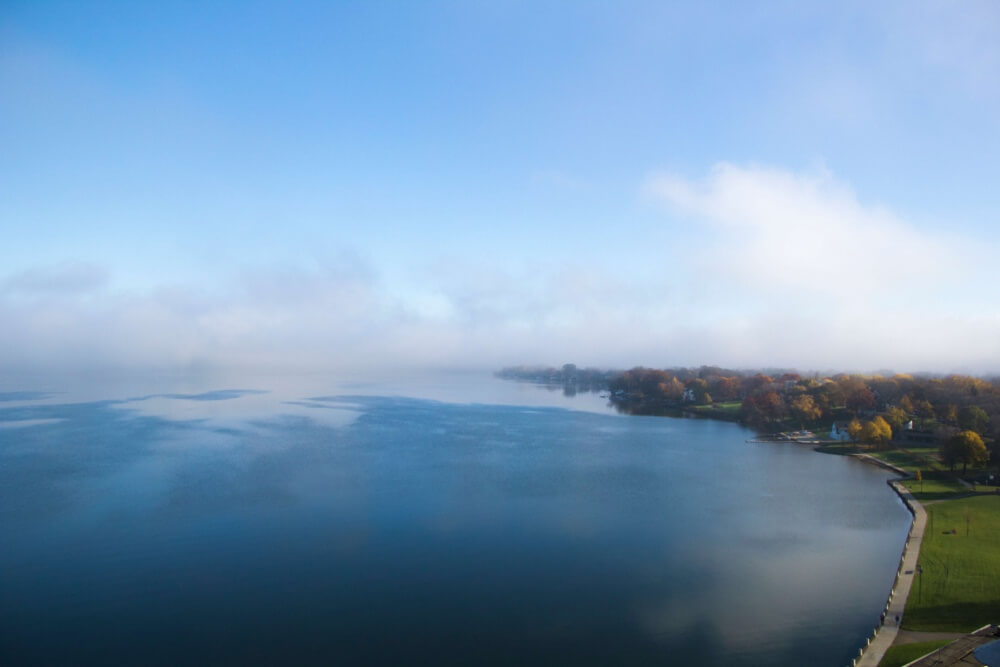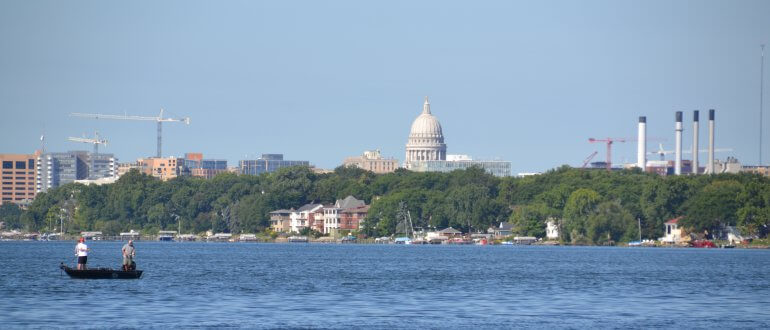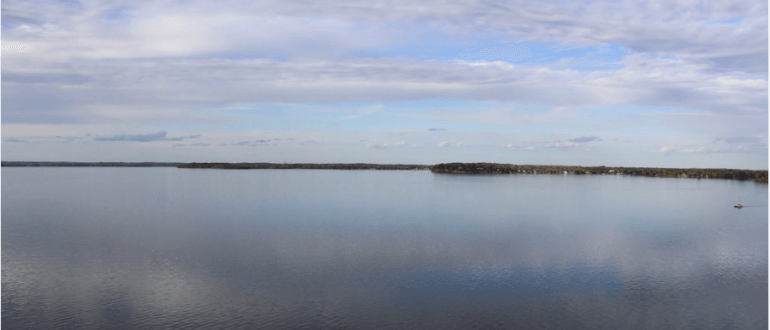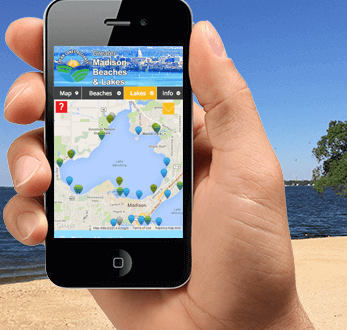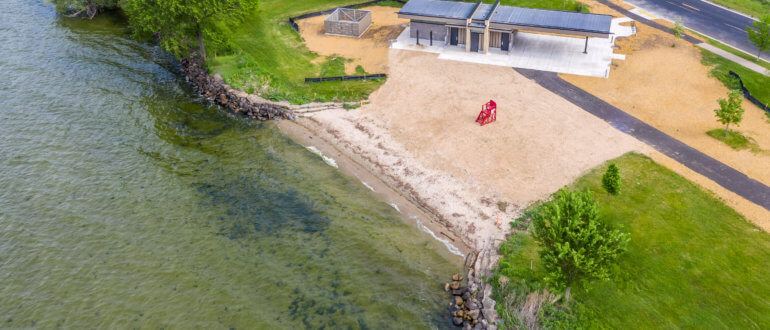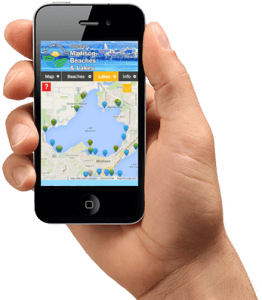2016 sees clearer water on Madison’s lakes
Clean Lakes Alliance volunteer monitors see improvements and mixed results
MADISON, Wis. — Clean Lakes Alliance has released results from the 2016 monitoring season on lakes Mendota, Monona, Wingra, Waubesa and Kegonsa. Over the past three years, the volunteer-based program has grown into an extensive 70-site effort to track water conditions near the shore, where most people interact with our lakes.
Keeping our Lakes Healthy is a Community Job
At Clean Lakes Alliance, we know keeping our lakes healthy is a community job.
Our partners at Dane County, the City of Madison, the Yahara Watershed Improvement Network, and numerous local municipalities and agencies commit significant time and resources to our lakes. Clean Lakes Alliance works closely with the staff and leadership to support this work and to raise public support for healthy lakes. Clean Lakes Alliance’s work to improve water quality is fueled by the community at large. We rely on support from people like you, donations made by businesses, money raised through events and sponsorships, contributions of time, skills or, equipment, and, of course, by grants. We regularly receive grants from both local and national organizations—which allow our work to be applied beyond our immediate community.
Lake Forecasting Steward
Join the fight for healthy lakes by making a tax-deductible donation today.
As a Lake Forecasting Steward, you will cover the fixed cost needed to supply one or more volunteers with monitoring equipment. This program allows Clean Lakes Alliance to inform the public of the latest water quality conditions at monitoring sites across lakes Mendota, Monona, Wingra, Waubesa, and Kegonsa.
What does my donation support?
$57.25: Turbidity Tube
$15.00: Thermometer
$27.75: Office expenses and supplies
$35.00: Friend of Clean Lakes
$135.00 = Lake Forecasting Steward Donation
Lake Forecasting Stewards receive all Friend of Clean Lakes benefits, including:
- Improve lake monitoring coverage by sponsoring equipment for one or more volunteers
- Plus, all Friend of Clean Lakes benefits including admission to Clean Lakes 101
You’ll also receive invitations to events, updates on work to improve water quality, and the assurance that Clean Lakes Alliance is working on your behalf on a daily basis with city, county, and state officials to put the Yahara lakes at the top of to-do lists.
Donors who make a gift at the $1,000 or more level are recognized each year through Clean Lakes Alliance’s Yahara Society.
Clean Lakes Alliance is a 501(c)(3), nonprofit organization. Your donation is tax-deductible!
Thank you for becoming a Lake Forecasting Steward!
State of the Lakes Report
2023 State of the Lakes
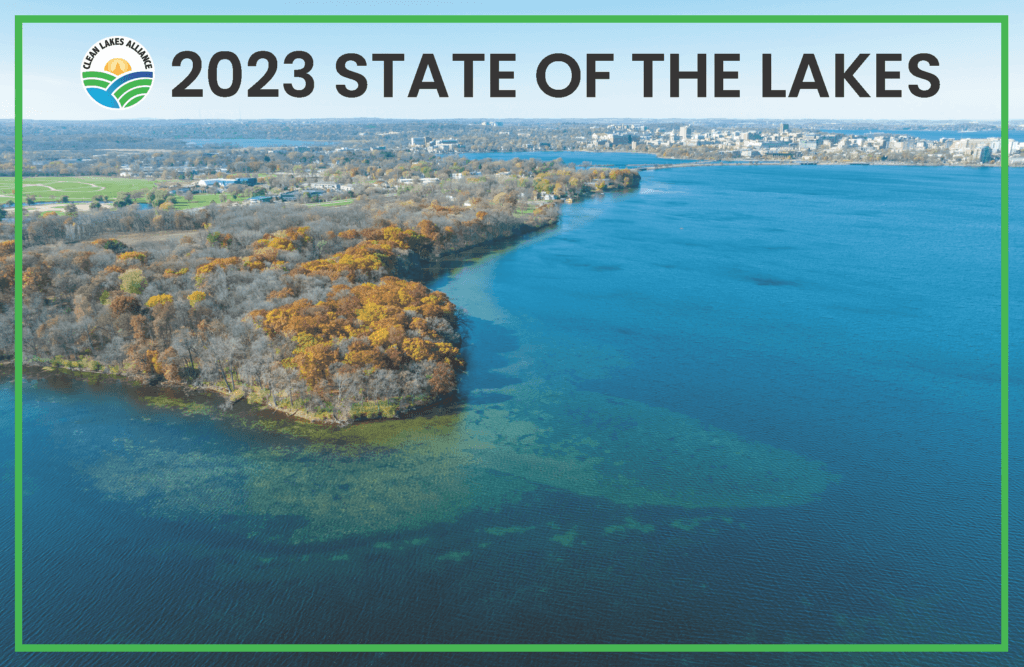
The State of the Lakes provides an annual health synopsis of Greater Madison’s five Yahara lakes (Mendota, Monona, Wingra, Waubesa, and Kegonsa). The chain of lakes and the land areas that drain to them are shown in Figure 1. Focusing on major drivers and indicators of water quality collected over the prior year (2023), the analysis summarizes lake and watershed health factors, trends, and the likely causes of observed conditions. The report begins with lake-specific health dashboards before reviewing five areas of watershed impact and lake response.
Authored by Clean Lakes Alliance Deputy Director and Chief Science Officer Paul Dearlove, this report is a product of collaboration involving multiple government and scientific contributors. We are grateful to the following entities and information sources: U.S. Geological Survey, University of Wisconsin-Madison, Wisconsin Department of Natural Resources, Wisconsin Salt Wise, Public Health Madison & Dane County, Dane County Land & Water Resources Department, and
Clean Lakes Alliance’s volunteer LakeForecast monitors.
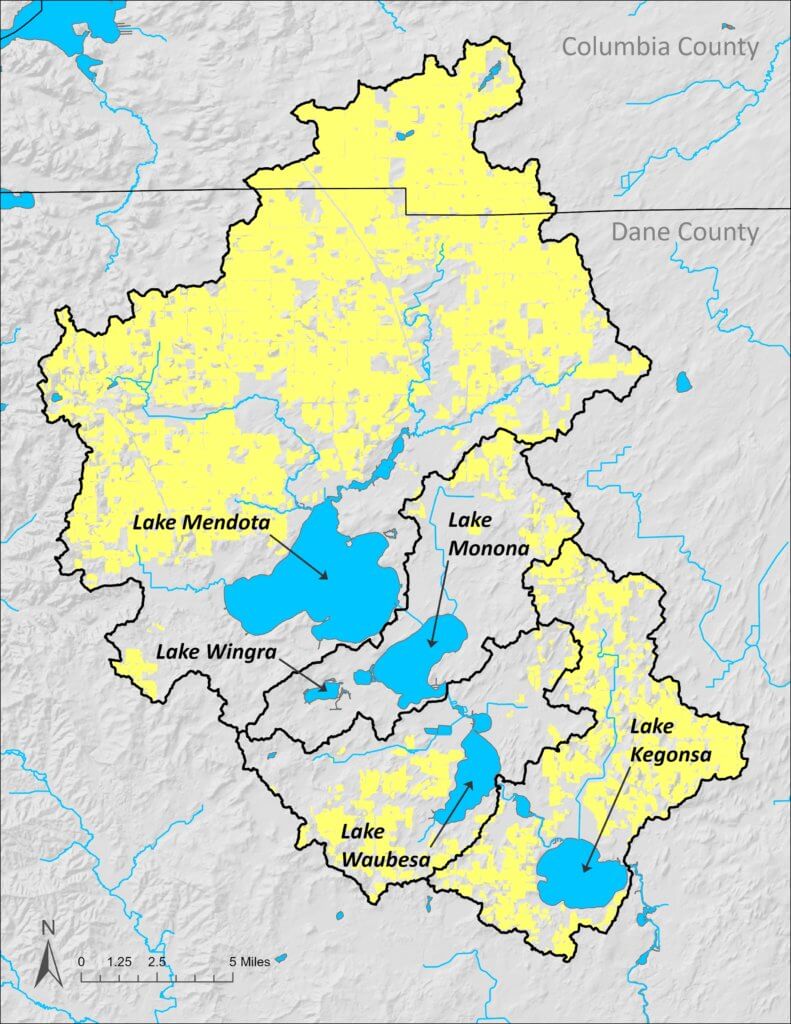
Figure 1: Yahara lakes watershed showing land areas that drain directly to each lake. Yellow denotes agricultural areas that comprise most of the 384-square-mile watershed.
2023 key takeaways
- Drought conditions limited runoff and phosphorus delivery to the lakes, helping all five lakes attain “good” to “excellent” rankings for phosphorus levels and “good” rankings for water clarity.
- LakeForecast monitors observed comparatively fewer nearshore cyanobacteria (blue-green algae) blooms compared to prior years.
- Historically rising chloride concentrations caused by winter salting is an ongoing water quality concern, with the highest levels measured in Lake Wingra.
- Per- and polyfluoroalkyl substances (PFAS) are an emerging contaminant of concern, with lakes Monona, Waubesa, and Kegonsa recently listed as federally impaired for these forever chemicals.
- Progress continues around the adoption of phosphorus-reducing land conservation practices, but more action is needed to reach and sustain water quality goals, including getting 100% of agricultural acres covered by nutrient management plans and developing more manure management facilities.
Lake Mendota
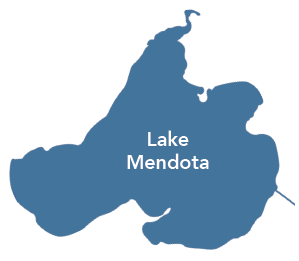
Lake Type: Drainage
Direct Drainage Area: 217 sq. miles
Total Drainage Area: 232.4 sq. miles
Surface Area: 9,847 acres
Shoreline Length: 22 miles
Mean Depth: 42 feet
Maximum Depth: 83 feet
Volume: 133,407 million gallons
Flushing Rate: 22% of volume/year
Lake Mendota sits at the top of the chain and is the largest of the five Yahara lakes by surface area, depth, and volume. Its direct drainage area consists predominantly of agricultural land uses. Inlet tributaries include Pheasant Branch Creek (west shore); and Sixmile Creek, Dorn Creek, Token Creek, and the Yahara River (north shore). The lake’s outlet (southeast shore) directs overflow water through the Yahara River and into Lake Monona. It has been listed as federally impaired for phosphorus since 2011.
Lake Mendota Health Dashboard
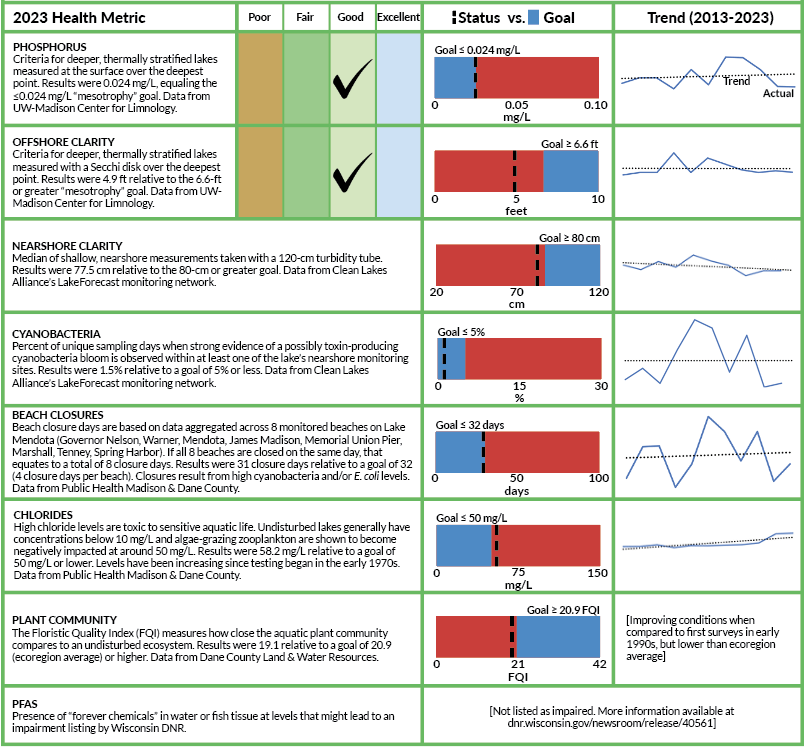
Lake Monona
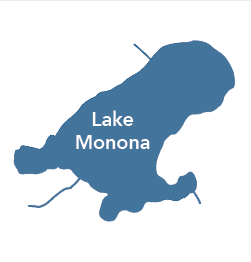
Lake Type: Drainage
Direct Drainage Area: 40.5 sq. miles
Total Drainage Area: 278 sq. miles
Surface Area: 3,277 acres
Shoreline Length: 13 milesMean Depth: 27 feet
Maximum Depth: 74 feet
Volume: 29,059 million gallons
Flushing Rate: 91% of volume/year
Lake Monona is the second largest of the five Yahara lakes by surface area, depth, and volume. It sits immediately downstream of Lake Mendota in the upper half of the chain. The lake’s direct drainage area consists mostly of urban land uses. Inlet tributaries flowing into the lake include Murphy’s (Wingra) Creek (west shore); the Yahara River (north shore); and Starkweather Creek (northeast shore). The lake’s outlet (south shore) directs overflow water through the Yahara River and into Upper Mud Lake and Lake Waubesa. It has been listed as federally impaired for PCBs since 1998, phosphorus since 2011, and PFAS since 2022.
Lake Monona Health Dashboard
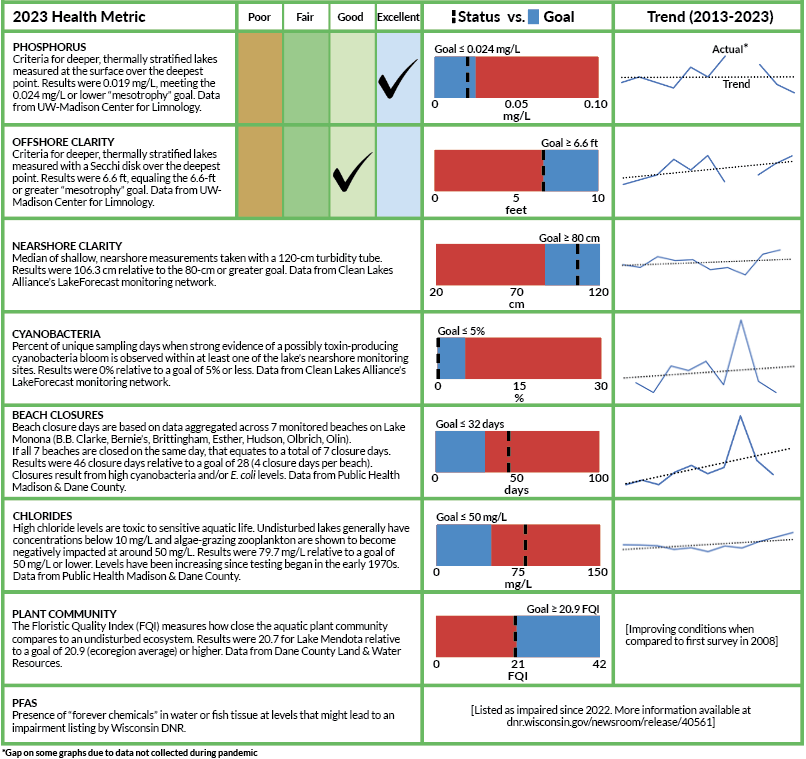
Lake Wingra
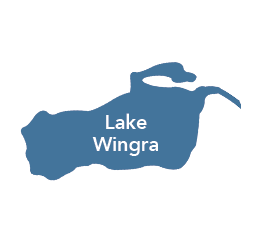
Lake Type: Drainage
Direct Drainage Area: 5.4 sq. miles
Total Drainage Area: 5.4 sq. miles
Surface Area: 321 acres
Shoreline Length: 3.7 miles
Mean Depth: 9 feet
Maximum Depth: 14 feet
Volume: 1,585 million gallons
Flushing Rate: 77% of volume/year
Lake Wingra is the smallest of the five major lakes by surface area, depth, and volume. Originally a deep-water marsh, this dredged waterbody now flows into Lake Monona via Murphy’s (Wingra) Creek. The lake’s direct drainage area is located entirely within the city of Madison and dominated by urban land uses. Three minor, unnamed inlet tributaries flow into the lake at points along its west and southwest shore. It has been listed as federally impaired for phosphorus since 2011 and PCBs since 2012.
Lake Wingra Health Dashboard
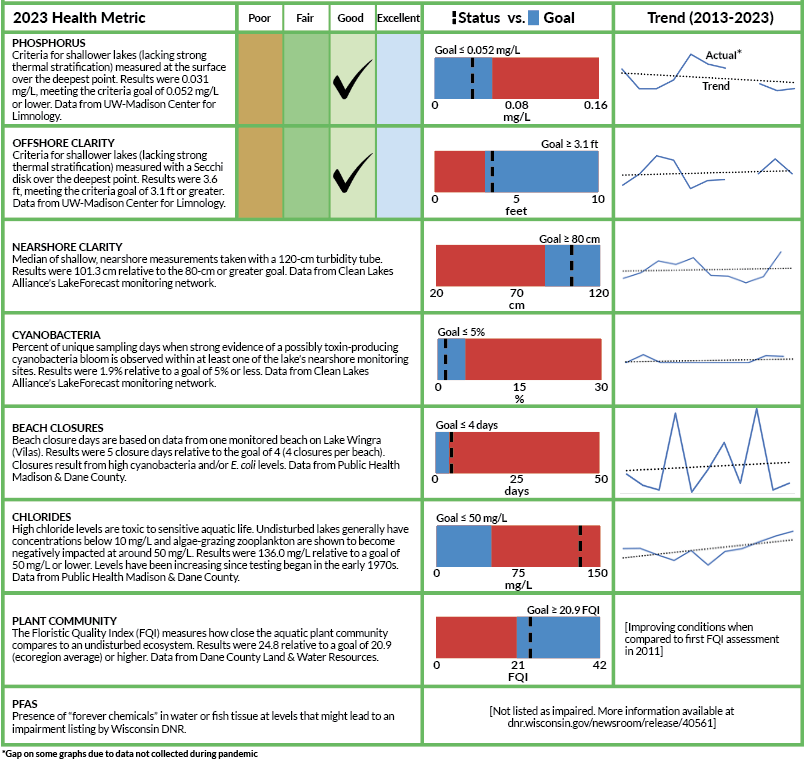
Lake Waubesa
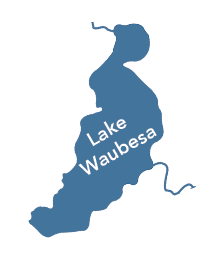
Lake Type: Drainage
Direct Drainage Area: 43.6 sq. miles
Total Drainage Area: 325 sq. miles
Surface Area: 2,083 acres
Shoreline Length: 9.4 miles
Mean Depth: 15 feet
Maximum Depth: 38 feet
Volume: 10,567 million gallons
Flushing Rate: 320% of volume/year
Lake Waubesa is the fourth largest of the Yahara lakes by surface area and volume. It sits immediately downstream of Upper Mud Lake and Lake Monona in the lower half of the chain. The lake’s direct drainage area is represented by a mix of urban and rural/agricultural land uses. Inlet tributaries that drain into the lake include Nine Springs Creek and Penitto Creek (flowing into Upper Mud Lake to the north); the Yahara River (north shore); as well as Swan Creek and Murphy’s Creek (southwest shore). The lake’s outlet (east shore) directs overflow water through the Yahara River and into Lake Kegonsa. It has been listed as federally impaired for phosphorus since 2011 and PFAS since 2022.
Lake Waubesa Health Dashboard
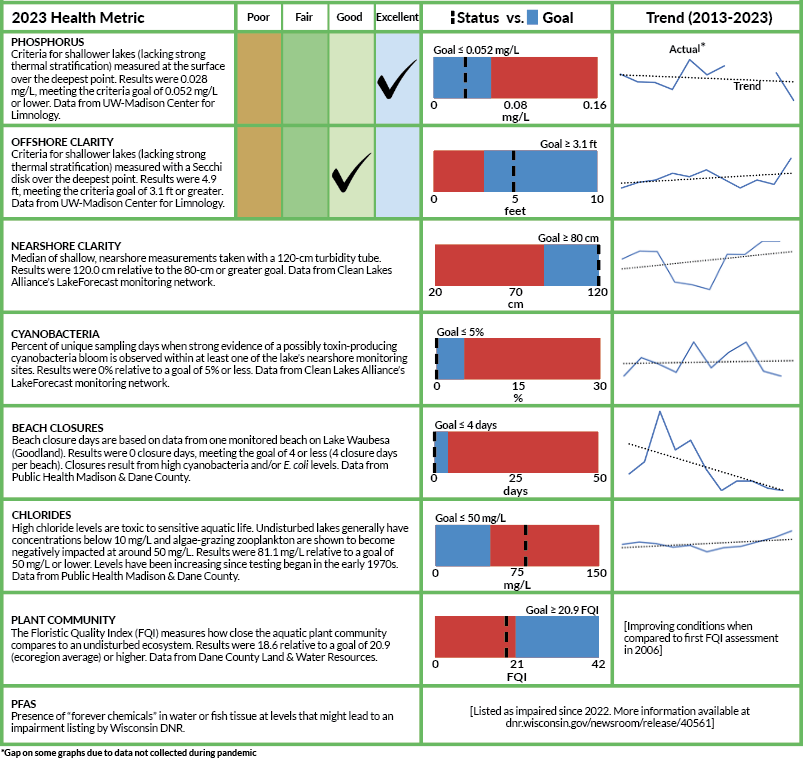
Lake Kegonsa
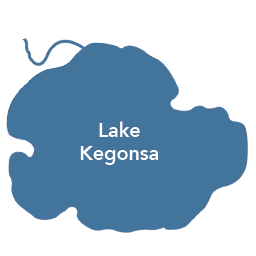
Lake Type: Drainage
Direct Drainage Area: 54.4 sq. miles
Total Drainage Area: 384.6 sq. miles
Surface Area: 3,210 acres
Shoreline Length: 9.6 miles
Mean Depth: 17 feet
Maximum Depth:32 feet
Volume: 17,700 million gallons
Flushing Rate: 220% of volume/year
Lake Kegonsa is the third largest of the Yahara lakes by surface area and volume. It sits immediately downstream of Lake Waubesa and Lower Mud Lake in the lower half of the chain. The lake’s direct drainage area consists predominantly of rural/agricultural land uses. Inlet tributaries that drain into the lake include Door Creek (north shore) and two unnamed creeks (southwest and northeast shore). The lake’s outlet (east shore) directs overflow water through the Yahara River toward the Rock and Mississippi Rivers. It has been listed as federally impaired for phosphorus since 2011 and PFAS since 2022.
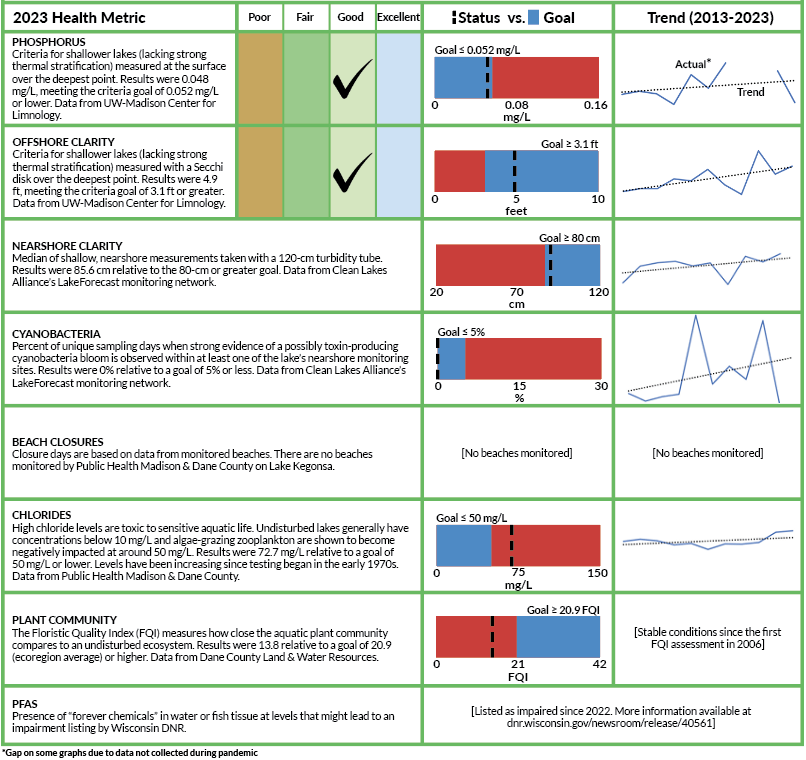
Watershed health indicators
The State of the Lakes assesses five areas of interest that represent vital, interconnected pieces of the larger water quality puzzle. These areas of analysis, illustrated in Figure 2, include both outputs (i.e., land-use actions taken) and outcomes (i.e., measured water quality responses). They were chosen to illustrate critical cause-and-effect principles that play out as water gets funneled through the watershed.
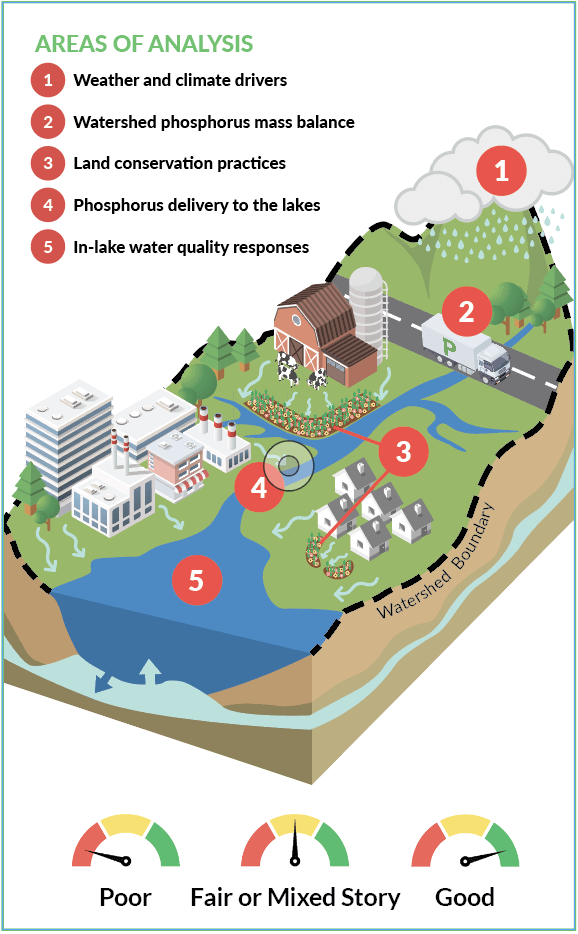
Figure 2: Cross-section illustration of an example watershed showing five areas of analysis. Example scoring dials represent condition status and trend for each area of analysis.
Phosphorus availability and transport are central themes in this analysis given the nutrient’s dominant role in affecting overall lake conditions. Although a natural element essential for plant and animal growth, it can easily harm water quality due to overuse and poor management. Common sources of phosphorus pollution include eroded soil, fertilizer runoff, autumn leaf debris left in city streets, poorly managed livestock manure, sewage releases, and uncollected pet waste. It is estimated that one pound of phosphorus can generate up to 500 pounds of algae growth in our lakes.
1. Weather and climate drivers
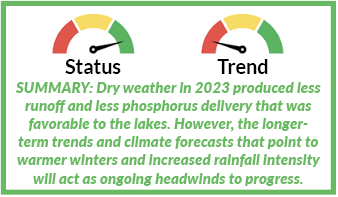
Regardless of whether it’s changes in temperature, precipitation, ice cover, or some other factor, lakes dynamically respond to their environment. Regional heating and cooling patterns influence what types of aquatic organisms can thrive, how and when a lake mixes, and the timing and magnitude of annual freeze cycles. Meanwhile, the timing, intensity, and amount of rainfall falling over the watershed determine what can get moved from the land surface into our waters, including phosphorus-containing materials that fuel algal growth and turn the lakes green.
Winter Season
Winter ice conditions and the timing of ice-off influence everything from water temperatures to the reproductive success of aquatic life. Ice quality and overlying snow depth affect how much sunlight can penetrate to warm the water column and facilitate dissolved oxygen production through photosynthesis. Research by Dr. Zachary Feiner at UW-Madison’s Center for Limnology documents the impacts of early ice-off. As ice-off dates move earlier due to climate change, algae production gets an early start and then collapses right when the daphnia (a type of zooplankton) hatch and are looking for food. This means less zooplankton to eat by juvenile fish and less grazing of algae. Resulting impacts can range from poorer walleye recruitment to more intense algal blooms.
In 2023, Lake Mendota remained frozen for 98 days (12/25/22 – 4/2/23), or 13 days longer than in 2022. This is on par with its median ice-cover duration of 102 days as measured over the last 168 seasons. Historical evidence shows ice-cover durations in decline, with Mendota having lost about a month of ice cover on average since recordkeeping began.
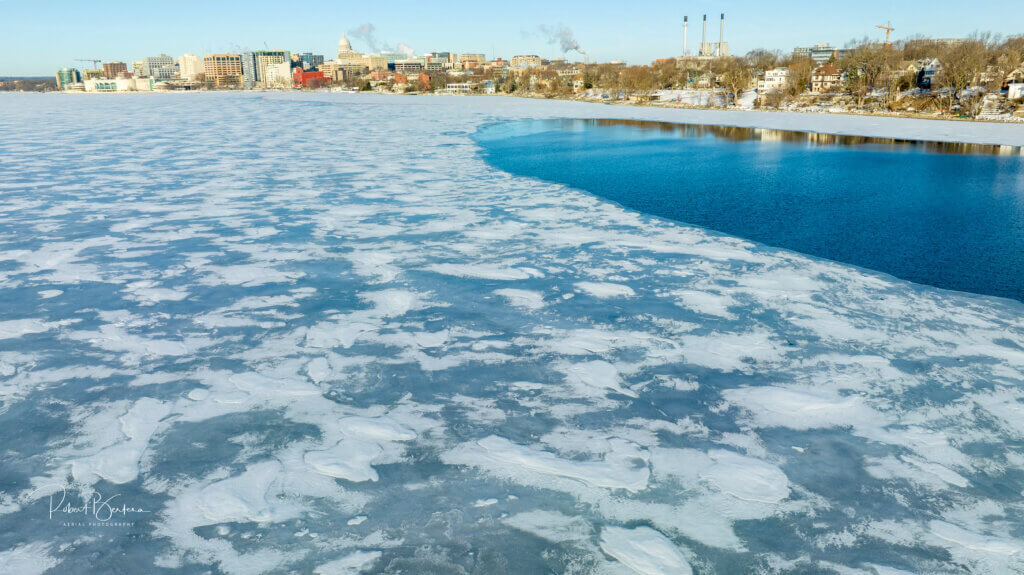
Shorter and warmer winters lead to warmer lake temperatures earlier in the year, effectively creating a longer growing season for algae and aquatic plants. Warmer winters can also contribute to greater runoff and phosphorus delivery when wet precipitation falls on frozen soils. Rather than soak into the ground, rainfall more easily turns into runoff that can carry land-spread manure and other contaminants into the ditches and streams that drain to the lakes. It is estimated that, on average, nearly half of the total phosphorus loading through Lake Mendota’s monitored stream tributaries occurs from January to March, making late winter and early spring a vulnerable time for our lakes.
Warmer Growing Season
The meteorological summer of 2023 (June 1-August 31) was Wisconsin’s sixth driest on record. Less rainfall leads to less stormwater runoff, meaning less phosphorus washing into our lakes. Based on weather data collected at the Dane County Regional Airport in Madison, the watershed transitioned from a three-year period of above-normal rainfall to a three-year period of below-normal rainfall.
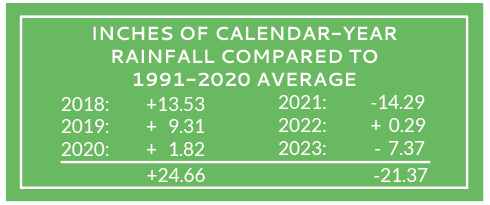
May and June’s collective rainfall totaled only 2.01 inches, compared to the normal 9.38 inches, with only one day receiving 0.50-inch or greater rainfall. The second half of the summer remained dry with July and August collectively experiencing only three days of 0.50-inch or greater rainfall. While July’s 6.21 inches surpassed the monthly normal (4.51 inches), drought conditions persisted with August receiving lower-than-normal rainfall (2.42 inches), further contributing to the already low lake levels. With 2023 capping a three-year period of below-normal rainfall, the impacts of reduced runoff were evident in lower phosphorus delivery (called “loading”) and positive water-clarity responses in all five lakes.
2. Watershed phosphorus mass balance
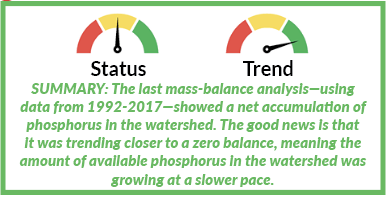
Calculating the difference between the mass of phosphorus entering (imported into) and leaving (exported from) the watershed tells us whether the net balance is trending in the right direction. The movement and fate of livestock, feed, fertilizer, harvested crops, animal waste, and other phosphorus sources are factored into the analysis. The goal is to attain a negative balance, indicating more phosphorus is being exported than imported on an annual basis. This situation reduces the overall availability of phosphorus from being able to reach area waterways.
Conversely, a positive balance signals an annual net accumulation of phosphorus in the watershed, usually leading to its gradual buildup in area soils. Phosphorus-saturated soils that are subject to erosion and not protected by year-round plant cover can eventually end up at the bottom of nearby lakes and streams. Phosphorus is also more easily “leached” (or released in dissolved form) from these soils when they encounter rainwater and snowmelt.
Past improvements to the overall mass balance are attributed to multiple factors. They include decreases in imported commercial fertilizer, less phosphorus-containing feed supplements consumed by livestock, exported byproducts of manure treatment, and advanced phosphorus-management strategies implemented by Madison Metropolitan Sewerage District (among others). Examples of mass balance detractors include increases in livestock numbers and milk production.
3. Land conservation practices
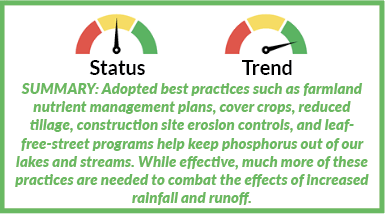
The adoption of land conservation practices helps minimize the amount of runoff and soil erosion that harms water quality. Examples include preserving and increasing perennial grasslands and natural vegetation, establishing permanent vegetation, maintaining protective cover crops on harvested farm fields, raising livestock on rotationally grazed pastures, and removing fall leaf litter from city streets. In addition, the use of nutrient management plans helps agricultural producers better understand how operational decisions can maximize soil health and productivity while limiting erosion and phosphorus runoff.
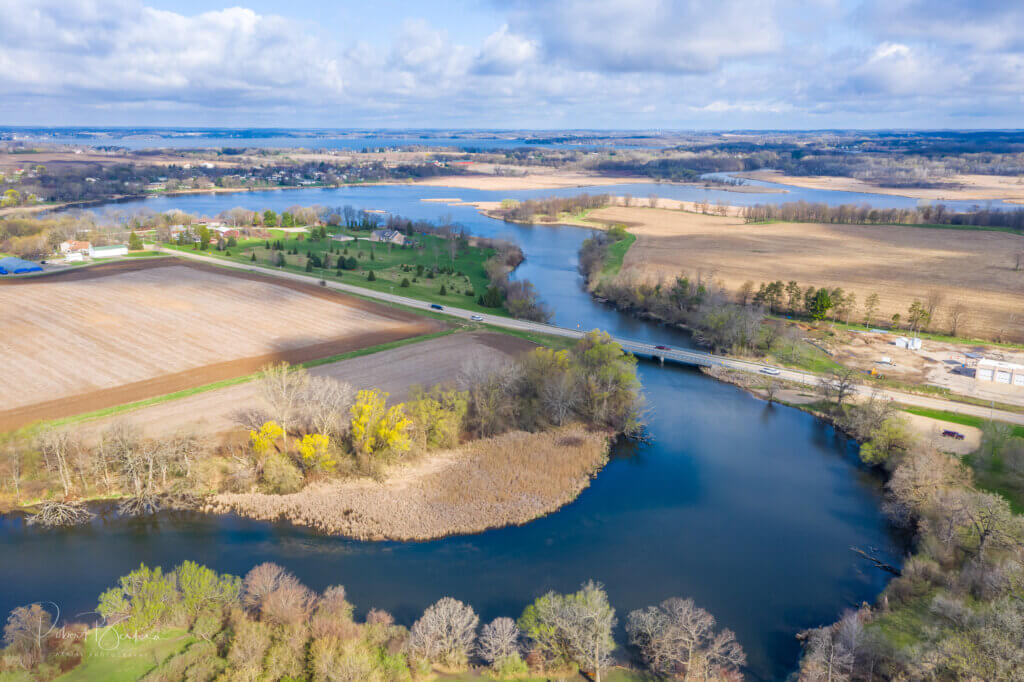
In accordance with state law, nutrient management plans are required on all farms to serve as nutrient-accounting tools, ensuring that manure and fertilizer applications meet crop needs while limiting runoff risks. Based on the latest landowner records filed with Dane County Land & Water Resources (Figure 3), 44,387 out of 84,321 total agricultural acres in the Yahara lakes watershed (53%) were mapped as having a nutrient management plan in 2023 – a 36% increase over just the last seven years. These numbers are believed to be an underrepresentation of the total amount of watershed acres under nutrient management planning since not every plan is recorded with Dane County. Achieving 100% compliance will be a big step forward in attaining related phosphorus reductions that come with sound planning.
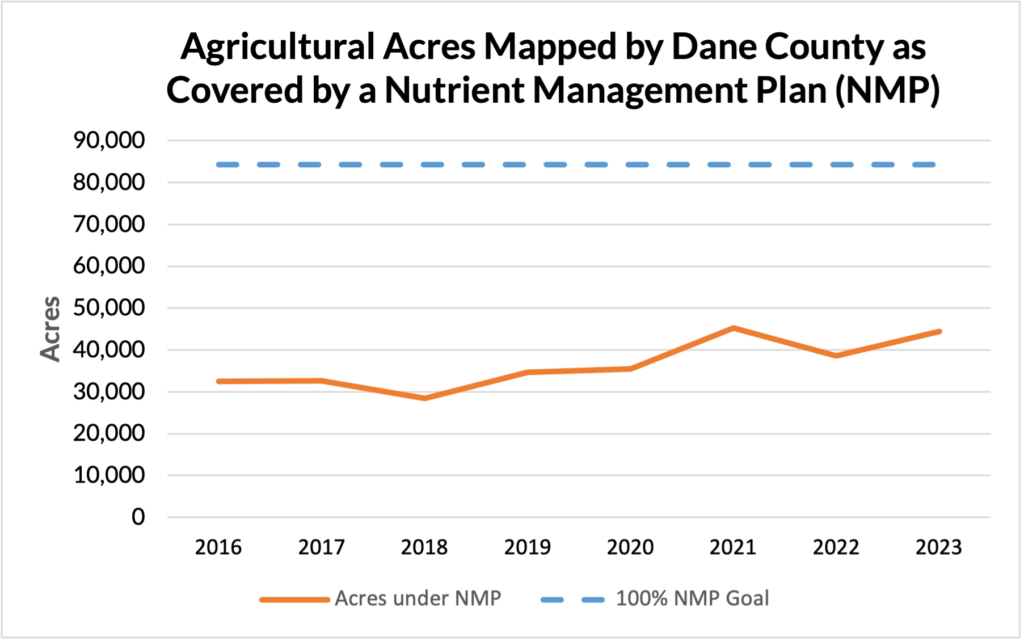
Currently, available soil-test information from farmland in the upper half of the watershed has a Rotational Average Phosphorus Index (PI) of 2.8, representing estimated pounds of phosphorus loss per acre per year. The Phosphorus Index is a tool used to assess the potential of phosphorus to move from agricultural fields to surface water, with higher numbers representing greater risk. According to modeling summarized in RENEW THE BLUE: A Community Guide for Cleaner Lakes & Beaches in the Yahara Watershed (2022), a Rotational Average PI of 2.1 or less is needed to reach phosphorus-loading targets and water quality goals in the Yahara lakes. Since 2016, values in the upper watershed north of Lake Mendota have averaged between 2.3 and 3.3. State standards require all fields covered by a Nutrient Management Plan to have a Rotational Average PI of 6 or less.
4. Phosphorus delivery to the lakes
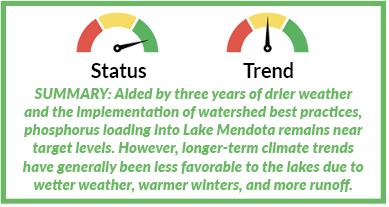
Most phosphorus is delivered to the Yahara chain of lakes through tributary streams that collect and channel upland-generated runoff as it moves downhill. How much is transported depends on the seasonal timing and intensity of runoff events, the location and availability of major phosphorus sources, and measures taken to contain those sources and manage runoff. Over the course of an average year within the past decade, approximately 40% of the total phosphorus load occurred during the months of January, February, and March.
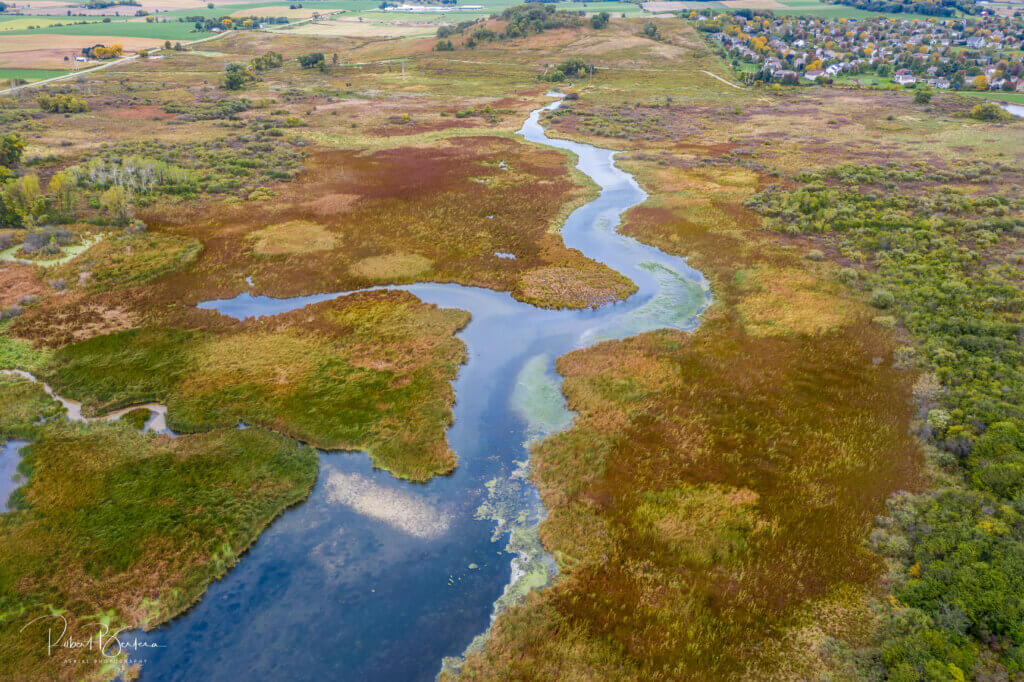
Stream monitoring is used as a tool to evaluate the effectiveness of conservation practices by tracking phosphorus loading. Loading describes the total mass of phosphorus delivered to a specific location in a stream over time. In our case, we characterize loading in pounds of phosphorus (calculated by multiplying in-stream concentrations by streamflow) delivered through Lake Mendota’s monitored stream tributaries in a given “water year” (Oct. 1 – Sep. 30). Perched at the top of the chain and receiving most of the drainage from the Yahara lakes watershed, the condition of Lake Mendota offers a good indicator for how the downstream lakes will be impacted. Lake Mendota is also the largest lake with the greatest number of monitored streams and the most complete long-term dataset. Most of the phosphorus received by the lower lakes in the chain is through the outlets of the upper lakes as it cascades through the system.
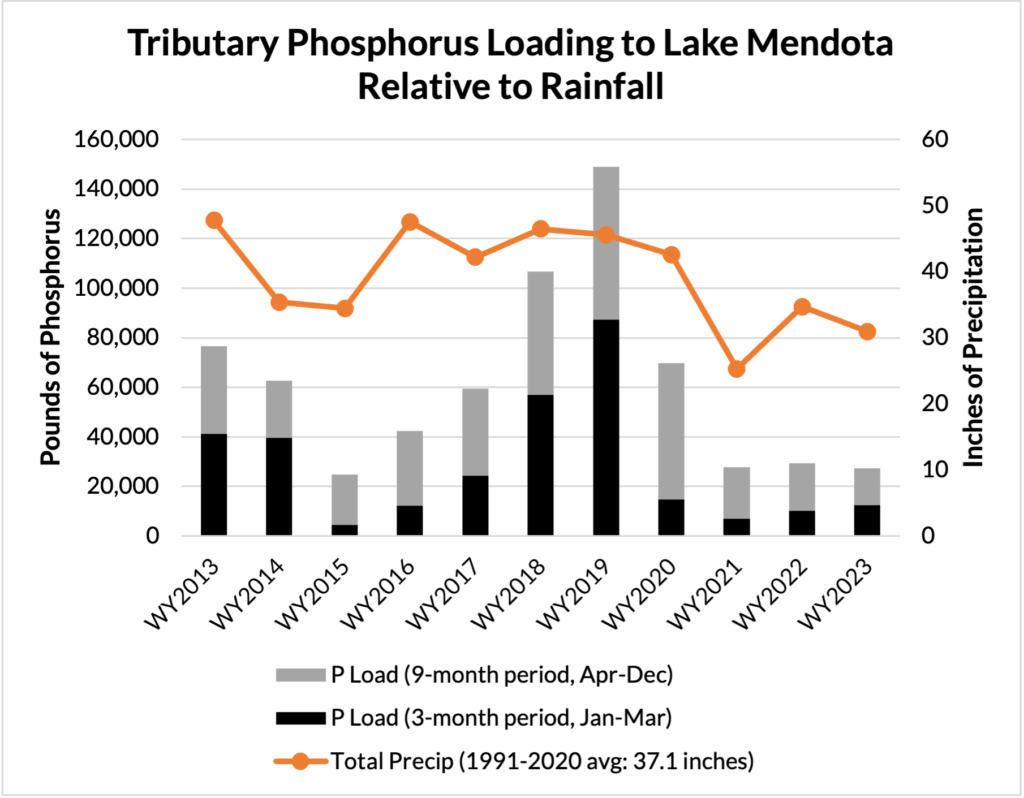
Figure 4 shows the change in stream-monitored phosphorus loading since 2013. Total precipitation is also plotted in orange to distinguish between wet and dry years. From 2021-2023, average annual phosphorus loading to Lake Mendota significantly declined and has even dipped slightly below target levels. This was largely due to drier weather after years of above-average precipitation, reducing the amount of runoff transporting phosphorus to the lakes. Scientists estimate a doubling of summer days when the lakes are clear and free of algal blooms if these lower levels can be maintained.
5. In-lake water quality responses
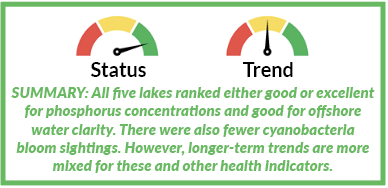
Several in-lake metrics are used to assess overall lake health and track changes over time. Those metrics include water clarity, phosphorus concentration, presence of cyanobacteria (blue-green algae) blooms, and beach closures. Each is summarized in the following figures. All five lakes fared relatively well in 2023 based on these specific health indicators, ranking good to excellent for phosphorus and good for clarity.
Phosphorus
In-lake phosphorus concentrations for all five lakes were comparatively low relative to the prior 10 years, but without any obvious trends over this period (Figure 5). Even when looking at longer time horizons, trends are difficult to identify. When averaged across individual decades beginning in the 1980s, lakes Monona and Waubesa show slight downward trends while those for lakes Mendota and Kegonsa are not evident. This speaks to the reality that more work is needed to reduce phosphorus loading if we hope to improve upon prevailing trends.
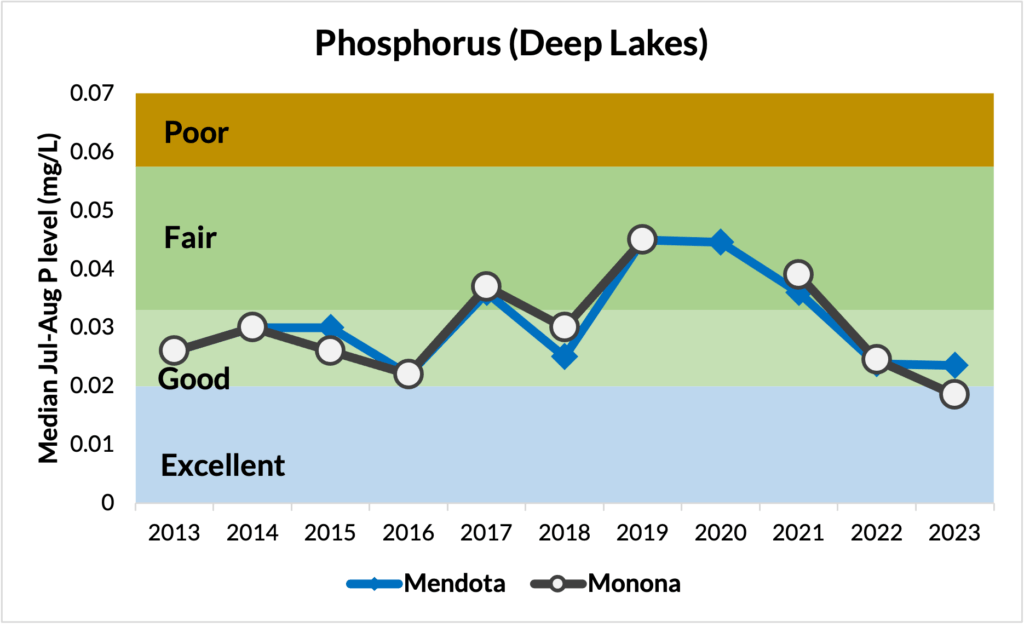
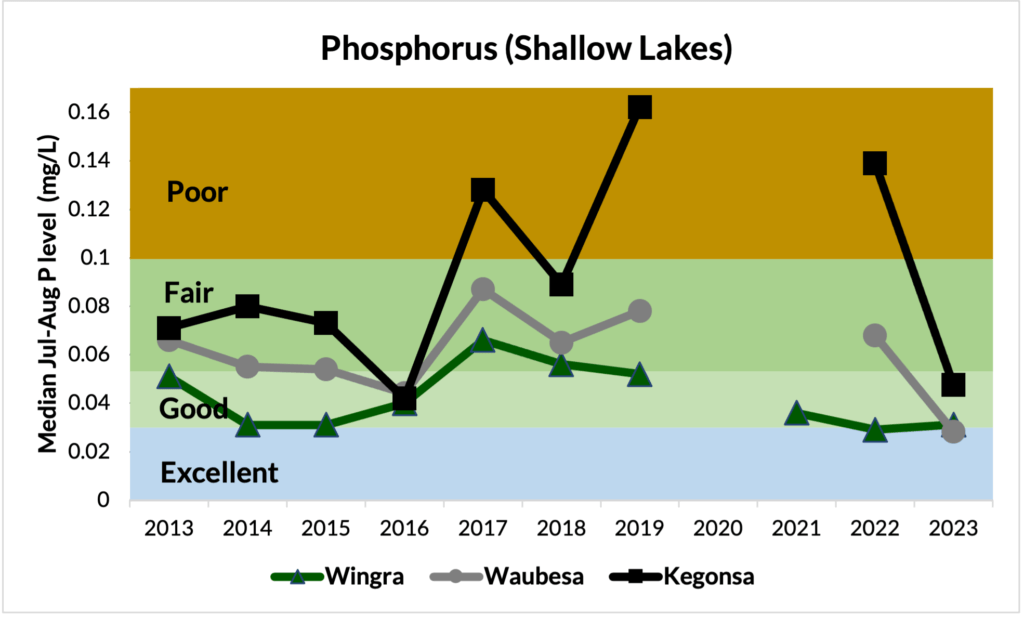
Recent drought years that limit phosphorus delivery because of reduced runoff loadings entering the lakes continue to have a positive effect on in-lake phosphorus concentrations. Lake Mendota’s concentrations after fall turnover hit a new record low in 2023 (Figure 6) following three years of relatively low external phosphorus loadings from the surrounding watershed. Turnover occurs when deeper lakes cool to the point where the water column can completely mix. Higher phosphorus concentrations that have built up throughout the summer in the bottom waters are then mixed throughout the lake. As less phosphorus enters the lake from the watershed, this bottom-water buildup of phosphorus is reduced, thereby reducing internal (in-lake) sources that can fuel algal growth the following year.
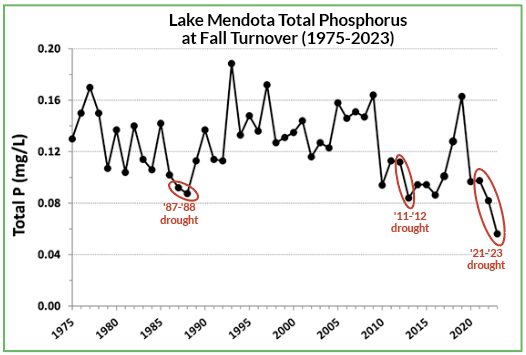
Credit: Richard Lathrop, UW-Madison Center for Limnology.
Fall turnover phosphorus concentrations were also low in 1988 and 2012 following those extended droughts. This shows that Lake Mendota’s phosphorus levels decline when loading from the watershed is reduced. Similar responses occurred following the wet, high-loading years of 2008 and 2018-19 when fall turnover phosphorus concentrations were very high. Soon after these years, Lake Mendota’s phosphorus status quickly dropped back to more average levels. This is another sign that reduced external loadings from the surrounding watershed can result in significant and relatively quick water quality improvements.
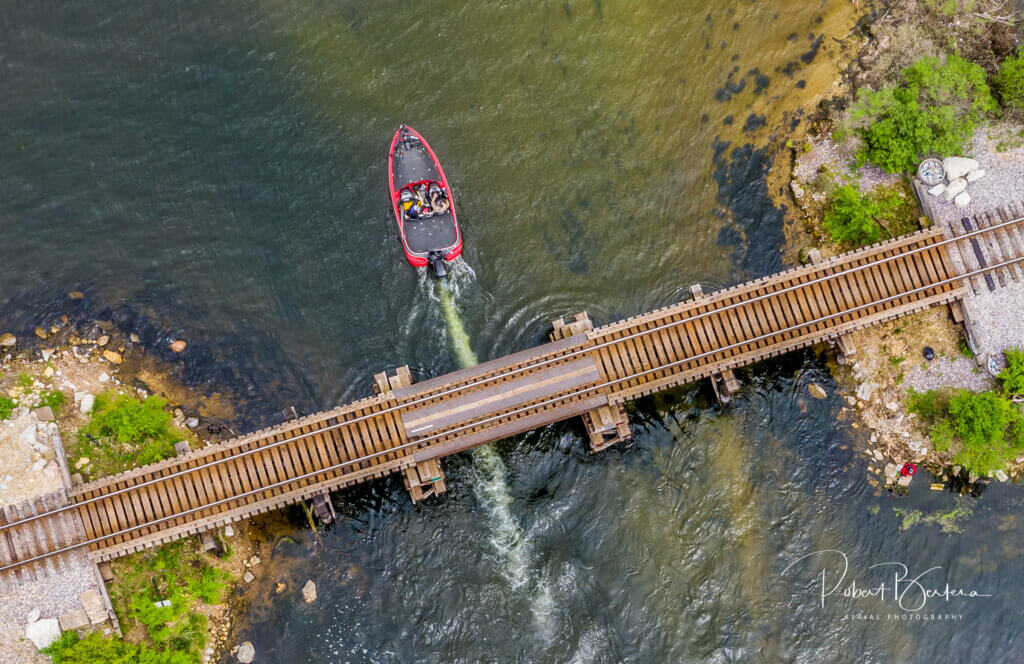
Water Clarity
Offshore water clarity for all five lakes was comparatively high relative to the prior 10 years, with median summer values generally trending higher over this period (Figure 7). However, when looking at longer time horizons, trends are more mixed. When averaged across individual decades beginning in the 1980s, lakes Mendota and Waubesa show slight downward trends while those for lakes Monona and Kegonsa are not discernible.
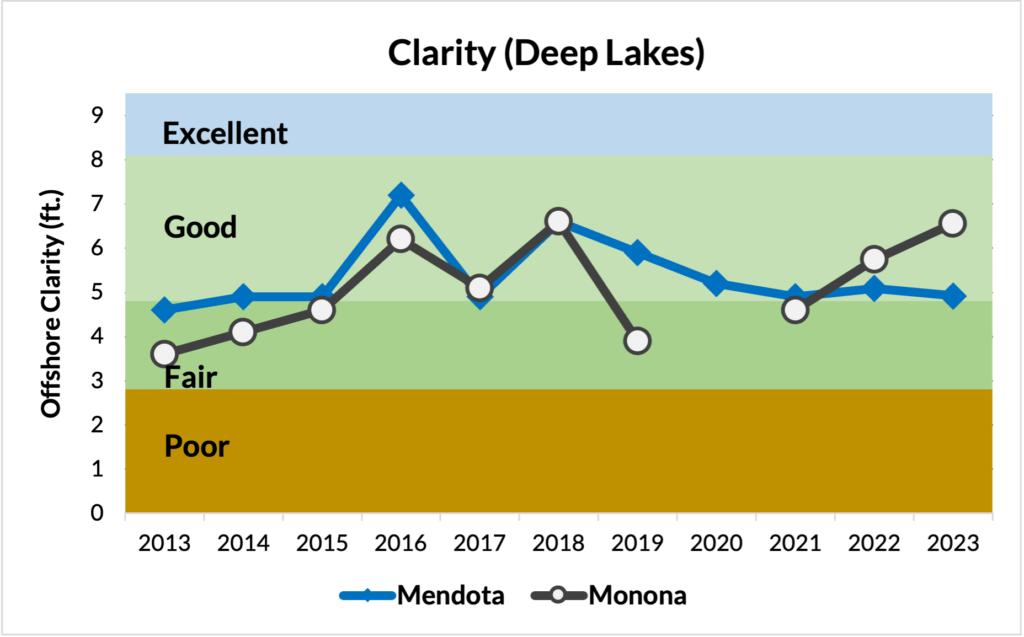
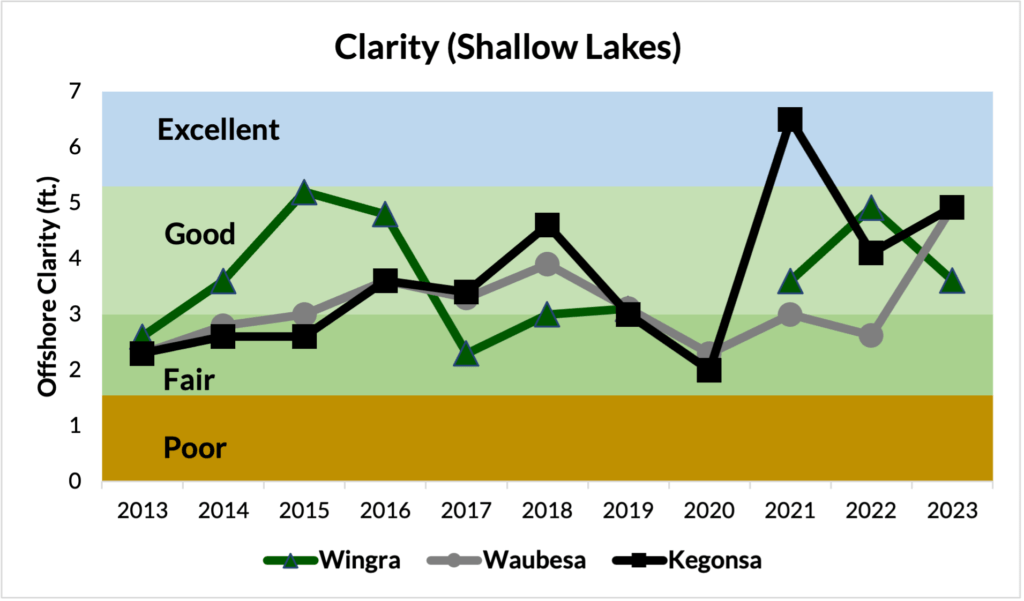
Because water clarity often varies across a given lake, Clean Lakes Alliance uses a network of trained volunteer monitors to collect additional data through its LakeForecast program. From Memorial Day through Labor Day, monitors submit at least twice-weekly reports on water clarity, water temperature, and the severity of floating green algae and cyanobacteria blooms (among other variables). This information can be seen in near-real-time on LakeForecast.org and the free LakeForecast app, allowing the public to stay up to date on current lake conditions. These reports are also used to raise awareness about changing water quality conditions, advocate for improvement projects, and inform this annual State of the Lakes.
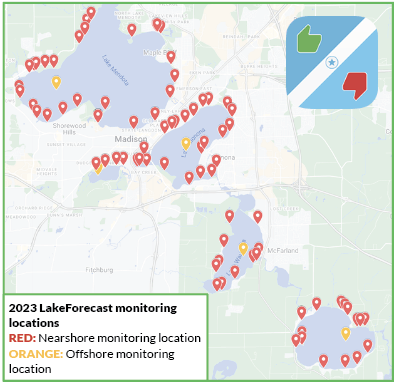
To measure nearshore clarity, monitors use a sampling device called a turbidity tube to report conditions at nearly 90 sites spread around all five lakes (Figure 8). Figure 9 shows the median summer (Jul-Aug) clarity readings for each lake from 2014-2023. Values under 50 as measured on the 120-cm device are considered “murky,” between 50-80 “fair,” and between 80-120 “good.” Consistent with offshore clarity readings using a Secchi disk, most values for 2023 fell within the good range, except for Lake Mendota which was at the upper range of fair.
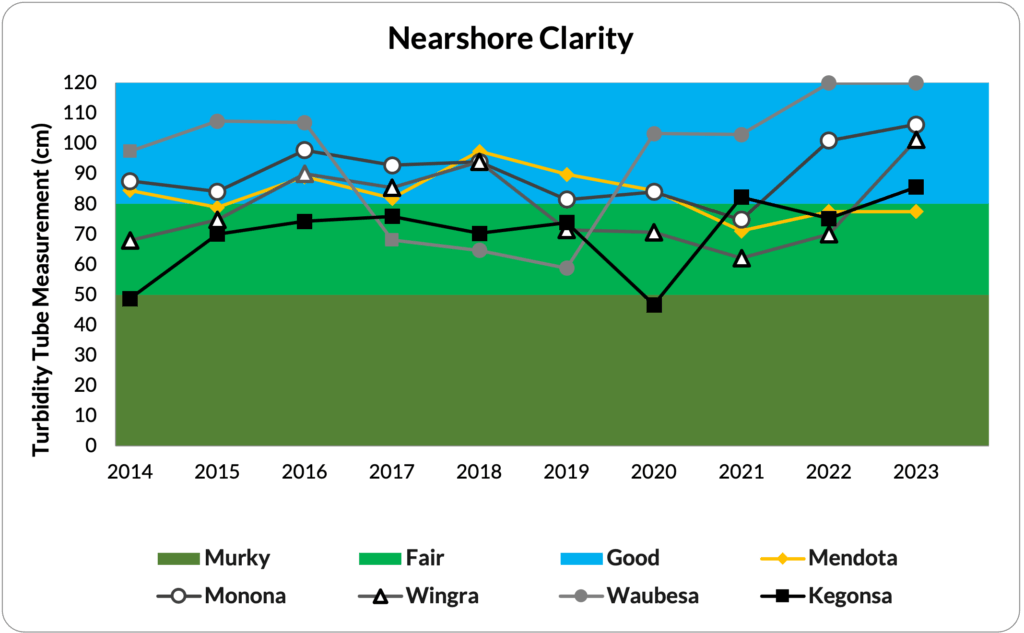
Cyanobacteria Blooms
To determine cyanobacteria bloom frequency, the number of days on each lake with at least one report of a strong cyanobacteria bloom observed within the individual monitoring sites was counted. By dividing the number of “cyanobacteria bloom days” by the total number of sampling days for each lake, a percentage is generated representing how often the monitors observed at least one major bloom within their sampling area. This method lessens overreporting in situations when different monitors report the same cyanobacteria bloom.
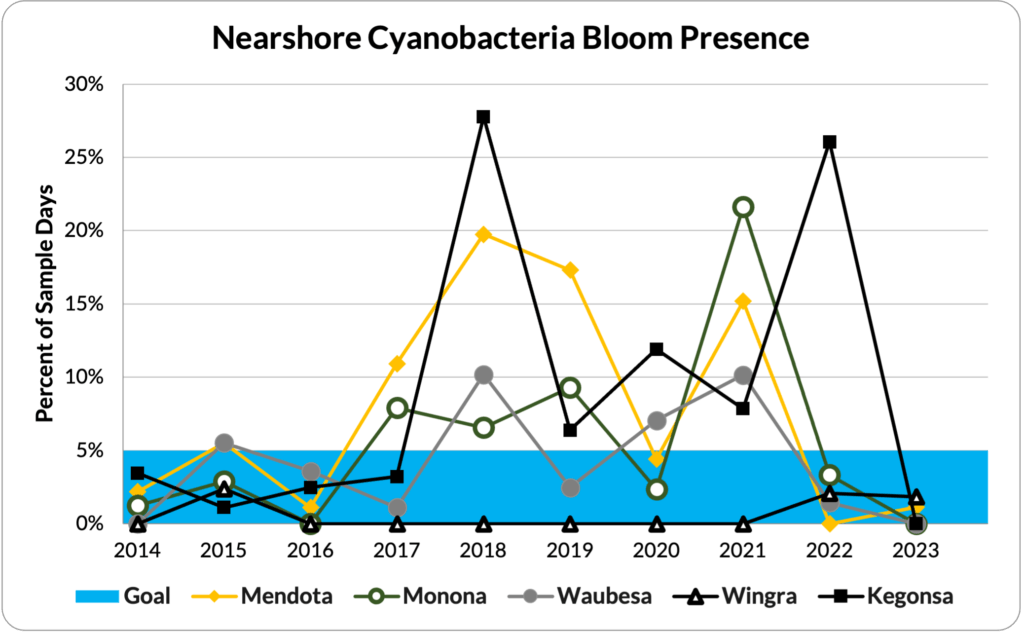
Figure 10 shows the percentage of sampling days when strong evidence of a cyanobacteria bloom was observed on each lake (2014-2023). Overall, monitors reported comparatively low cyanobacteria blooms during the 2023 sampling period (Jun-Aug), with most of the significant blooms occurring early in the season. Monitors on lakes Monona, Waubesa, and Kegonsa did not report a single significant bloom. This is welcome news after 2022’s record-high bloom count on Lake Kegonsa. Lake Wingra experienced similar bloom counts to 2022, and Lake Mendota had a handful of significant blooms reported in 2023 after not experiencing any in 2022.
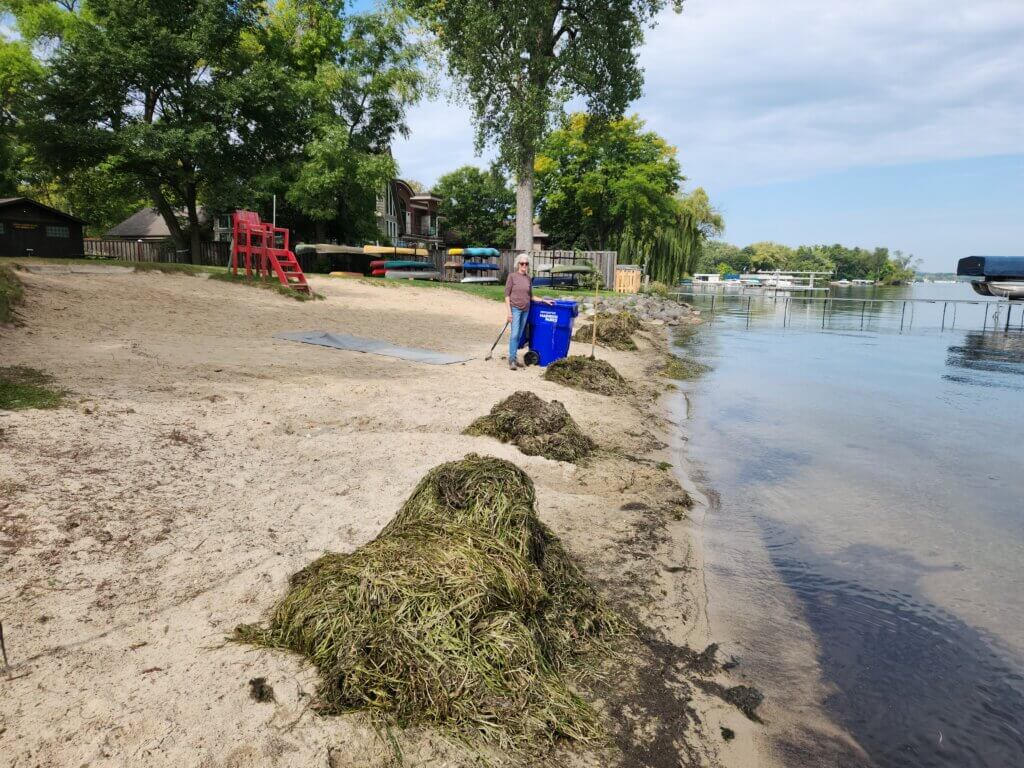
Beach Closures
Beach closures are another useful indicator of general lake health. Clean Lakes Alliance looks at closure data provided by Public Health Madison & Dane County for 17 beaches (Figure 11). Covering four of the five Yahara lakes, these tested public beaches were selected due to the consistency of tracking data over the prior 10-year period. Results are reported as total closure days recorded for each season, roughly running from Memorial Day to Labor Day. For example, if two beaches on a given lake are closed for a total of five days each, 10 closure days would be reported for that lake.
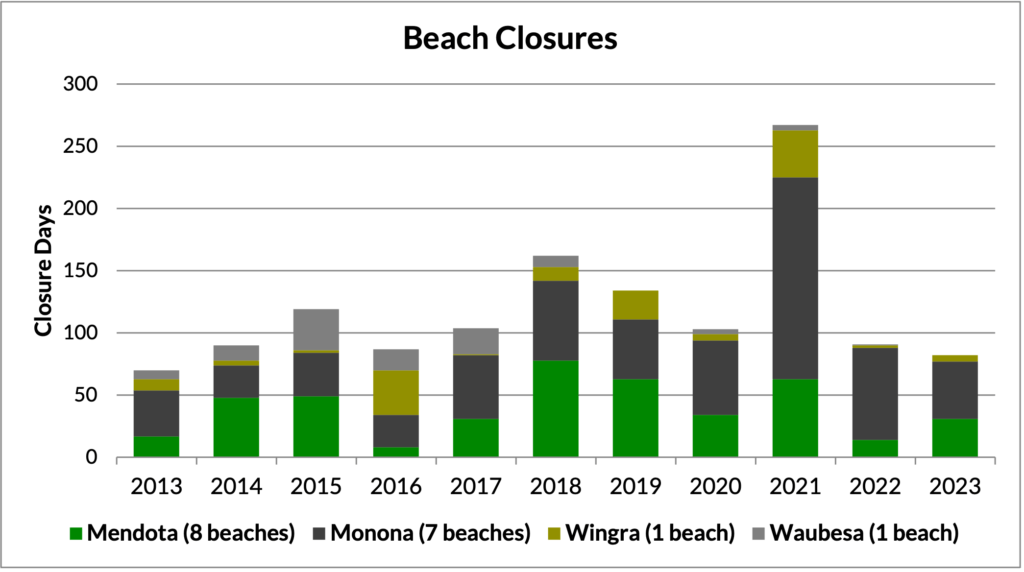
Closures are most often the result of high cyanobacteria and/or E. coli bacteria levels, with closure rates strongly influenced by timing and frequency of testing. Most beaches are tested once per week and then daily for beaches with a closure in effect. Cyanobacteria blooms, which are generally a product of high lake fertility, can be dangerous due to their potential to release toxins that can harm people, pets, and wildlife. High E. coli bacteria concentrations can also be harmful as they are an indicator of human or animal fecal matter in the water that may contain dangerous pathogens. In 2023, there were 82 beach-closure days reported, which is below both the long-term median and the 92 closures reported in 2022. Closures were relatively split between cyanobacteria and E. coli as the causes.
Growing Stewardship
Clean Lakes Alliance remains committed to fulfilling its vision of making Greater Madison renowned for its healthy lakes, lands, and waters. We do this through our daily mission to champion the lakes and watershed stewardship for the benefit of all. We are also proud to have assembled and led the 19-member partnership coalition, called the Yahara CLEAN Compact, that signed off on an updated lake-cleanup plan. RENEW THE BLUE: A Community Guide for Cleaner Lakes & Beaches in the Yahara Watershed (2022) reaffirmed goals and is now guiding action across multiple stakeholder groups.
Achieving and sustaining healthier local lakes is entirely possible. Increased awareness, involvement, and progress on needed project action are helping to move us in that direction. But more work and investment are clearly needed, and it will take all watershed stakeholders playing an active role to get us there. To learn more about the lakes and what you can do to help, visit cleanlakesalliance.org/renew-the-blue.
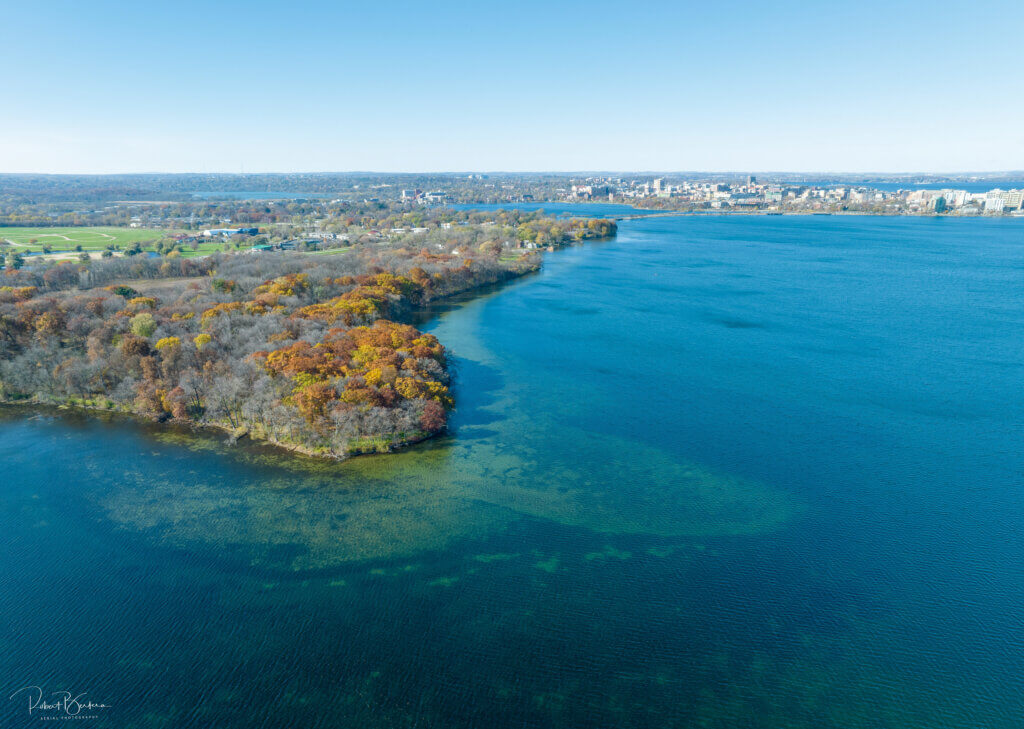
About the State of the Lakes
The annual State of the Lakes is released each year as part of the Greater Madison Lake Guide. In it, we report out to the community on the state of water quality in our lakes. The report also looks at our collective progress toward our phosphorus reduction goal.
The report highlights information from many partners to share the most up-to-date science on water quality in our lakes. We feature local projects, including work in urban areas to protect stormwater quality and progress on farms to keep nutrients on the fields and out of our lakes.
In addition, we provide more information about Clean Lakes Alliance and our efforts to engage the community and advocate for the lakes. This report serves as a reference and a resource, highlighting community progress toward cleaner, healthier lakes for all.
Learn more about our lakes
Learn more about lakes Mendota, Monona, Wingra, Waubesa, and Kegonsa.
Past reports:
- 2022 State of the Lakes
- 2021 State of the Lakes
- 2020 State of the Lakes Report
- 2019 State of the Lakes Report
- 2018 State of the Lakes Annual Report
- 2018 Progress and Challenges video – shown at the 2019 Community Breakfast “Join the Wave”
- 2017 State of the Lakes Annual Report
- 2016 State of the Lakes Annual Report
- 2015 State of the Lakes Annual Report
- 2014 State of the Lakes Annual Report
- 2013 State of the Lakes Annual Report
- 2012 Annual Report / 2012 State of the Lakes Report
- 2011 State of the Lakes Report
Search our website for something else:
Loop the Lake
Loop the Lake 2024
2024 Loop the Lake Benefit Bike Ride
Support clean, healthy lakes with Clean Lakes Alliance’s 12th Annual Loop the Lake Bike Ride, presented by Lake Ridge Bank. Loop the Lake is an at-your-own-pace bike ride around Lake Monona on Saturday, June 15th that raises funds to protect and preserve Greater Madison’s lakes. Make a day of it while you enjoy entertaining and educational activities at many parks along the route.
Event details
Cyclists of all ages and abilities navigate the scenic 13.8-mile loop around Lake Monona.![]() Saturday, June 15th
Saturday, June 15th![]() Starting & ending at Olbrich Park (3527 Atwood Avenue, Madison)
Starting & ending at Olbrich Park (3527 Atwood Avenue, Madison)![]() Course open 9 a.m. – 2 p.m. (optional group start at 9 a.m.)
Course open 9 a.m. – 2 p.m. (optional group start at 9 a.m.)![]() $45 per in-person rider, kids 10 and under ride free with a paid adult
$45 per in-person rider, kids 10 and under ride free with a paid adult![]() Get a group to ride – purchase 6 adult registrations for the group rate of $200
Get a group to ride – purchase 6 adult registrations for the group rate of $200
Registration includes
![]() Fun and educational stops (see information below)
Fun and educational stops (see information below)![]() Super soft t-shirt, compliments of Lands’ End
Super soft t-shirt, compliments of Lands’ End![]() Food cart item
Food cart item![]() Free beer or seltzer, courtesy of Bell’s Brewery (21+)
Free beer or seltzer, courtesy of Bell’s Brewery (21+)
Loop the Lake is more than a bike ride – it’s an opportunity for our community to connect with our lakes! Event proceeds will support Clean Lakes Alliance’s work to protect and improve our lakes through on-the-ground projects, educational programs, and water quality monitoring.
You can also choose to ride, walk, run, or paddle from anywhere, at any time! Register for the virtual option for $55 and we’ll mail your shirt!

Sign up below to become a 2024 Loop the Lake sponsor
Learn more about sponsorship opportunities.
About the Ride
Join us on the official Monona Lake Loop by starting and ending at Olbrich Park (3527 Atwood Avenue, Madison) on Saturday, June 15th, 2024. The course will be open from 9 a.m. until 2 p.m. so that riders can ride at their own convenience. An optional group start will take place at 9 a.m. Riders will travel 13.8 miles clockwise around Lake Monona. Most recreational bikers will finish in around two hours.
You can also choose to ride, walk, run, or paddle virtually, from anywhere at any time!
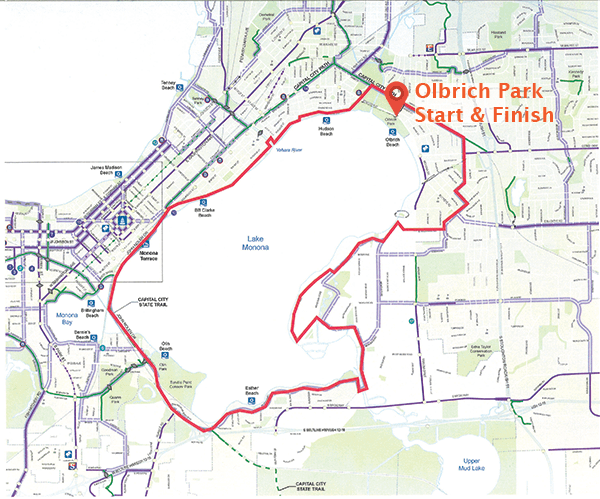
During the ride
- This is a relaxed, fun, at-your-own-pace ride. Please follow course markings, watch for detours, be careful of cars sharing the road, wear a helmet, and obey all traffic laws.
- Watch for fun stops along the route – see information below
- Make sure you complete the course by 2 p.m. to use your free food cart item and drink tickets
- Bike repairs stations located at Schluter Park and Off Broadway Drafthouse
Stops along the route
- Schluter Park – Get a sweet treat from Monona Police
- Winnequah Park – Education station with Aldo Leopold Nature Center – learn about small aquatic critters in our lakes
- Grand Crossing Park – hear the salsa band, Orquesta SalSoul
- Off Broadway Drafthouse – get a free root beer float and water, or purchase a cold beverage
- Olin Park (join us in the wedge between the park and the bike path) – visit with Friends of Nolen Waterfront and enjoy a water station
- BB Clark Beach Park – enjoy water and snacks
- Hudson Park – learn about the history and significance of this sacred site from expert guides from Ho-Chunk Nation and UW-Madison in this special effigy mound educational stop
- Olbrich Park – enjoy a free food cart item from one of Greater Madison’s favorite food carts
Registration
Registration includes an event t-shirt, courtesy of Lands’ End, and a beer or seltzer (21+), courtesy of Bell’s Brewery. Your registration supports critical work by Clean Lakes Alliance to keep our lakes at the top of the community agenda.
Registration: $45 per in-person rider. FREE for children 10 & under with purchase of adult registration. $50 day-of registration at Olbrich Park.
If you would like a shirt size that isn’t listed, please email us at info@cleanlakesalliance.org.
Registrations are transferable but non-refundable. Loop the Lake is held rain or shine! In the event of cancellation, registrations and sponsorships will not be refunded. Your registration will be considered a donation to Clean Lakes Alliance. Thank you!

T-shirt distribution
Please select your t-shirt size by Wednesday, May 1st to make sure you receive your t-shirt before the event. T-shirts can be mailed to your home or business if you select the $55 ticket option:
EARLY PACKET PICKUP (2 OPTIONS):
- Wednesday, June 12th, 11 a.m. – 2 p.m. at Verex Plaza. We will be set up in the front driveway – just pull your car up and we will get you your ride packet.
- Friday, June 14th, Noon-6 p.m. Packet pickup will take place in front of The Biergarten at Olbrich Park (3527 Atwood Avenue, Madison).
DAY OF PICKUP: Pick up your shirt the day of the event on Saturday, June 15th at Olbrich Park (3527 Atwood Avenue, Madison) from 7:30 a.m. until 2 p.m.
Food carts at Olbrich Park
- Ben’s Soft Pretzels
- Bob’s BBQ Emporium
- David’s Jamaican
- DonutNV
- Egg Naanana
- El Gran Taco Gato
- Jakarta Café
- Forage Kitchen
- Momma Meg’s Ice Cream
- State Street Brats
Access for all
With help from MESBA, Clean Lakes Alliance is dedicated to making the 2024 Loop the Lake more accessible to all community members. Here are some options for this year’s ride:
- Rent an e-bike from Madison BCycle with special discounted pricing
- If you are in need of financial assistance, please request a Community Pass for free registration – Community Passes will be approved on a case-by-case basis
- Request to try an adaptive bike from Limitless Cycling
- Visually impaired participants can request to ride a tandem bike during the event
Please make any Access for All requests through this Google form.
Traveling for Loop the Lake?
Whether you are traveling to the area for the weekend or want to plan a “staycation,” our friends at Discover Monona have got you covered. See the list below for variety of options to spend the weekend in our community!
- AmericInn by Wyndham Madison South
- Avid Hotels Madison – Monona
- Country Inn & Suites by Radisson (receive a 12% discount with this link)
- Airbnb
- Vrbo
- Expedia
For more information visit discovermonona.com
Participant safety
Be safe during the Loop the Lake Bike Ride! Obey all traffic laws, be careful of cars sharing the road, and wear a helmet. Participants should obey all social distancing guidelines.
What to bring
Riders are encouraged to wear a bike helmet and sunscreen, and to bring their own reusable water bottle.
Volunteer at Loop the Lake
We are looking for volunteers to help make Loop the Lake a success. Volunteers are needed for event setup and cleanup, water distribution, packet pickup, and more. Volunteering your time is a great way to give back to the lakes.
Sign up to volunteer!
Terms & conditions
By registering for Loop the Lake, you agree to our Terms & Conditions of Entry.
Refund policy
Registrations are transferable but non-refundable. In the event of cancellation, registrations and sponsorships will not be refunded. Thank you for your donation to Clean Lakes Alliance!
Weather conditions
Please be prepared for the weather with appropriate clothing and sun protection. Loop the Lake will be held rain or shine! However, should unsafe weather conditions arise, we will notify riders of event cancellation by email.
Sponsorships
If you would like to learn more about sponsorship opportunities, contact our Executive Director, James Tye, at james@cleanlakesalliance.org or 608-255-1000.

Thank you, 2024 sponsors!
Loop the Lake, presented by Lake Ridge Bank, is an annual event aimed at promoting the protection and preservation of Madison lakes. The event is produced in partnership with Platinum Hosts Discover Monona and Monona East Side Business Alliance (MESBA), and in conjunction with the City of Madison and the City of Monona. All proceeds support Clean Lakes Alliance, a nonprofit organization dedicated to improving and protecting the lakes, rivers, and wetlands in the Yahara Watershed.

Search our website for something else:
About Clean Lakes Alliance
Clean Lakes Alliance is a nonprofit organization devoted to improving the water quality of the lakes, streams, and wetlands of the Yahara River Watershed.
We are a unique partnership of diverse stakeholders who are building on and expanding upon decades of ongoing efforts to preserve and restore our waters.
Our goal is to raise community awareness of the issues facing the watershed, advocate for the welfare of our lakes, and help procure the necessary funding to clean and protect these waterways.
We work closely with state, county and local government agencies, waterway user groups, lakefront property owners, and community nonprofits to serve as both a positive voice for the promotion of our cherished lakes and a fundraising vehicle for achieving these ends.
Learn more about Clean Lakes Alliance:
Our Vision
We envision a community renowned for its healthy lakes, lands, and waters. Healthy Waters. Thriving Community.
Our Mission
Our mission is to champion our lakes and watershed stewardship for the benefit of all.
Our Values
Optimism – Together, we can build a better future knowing cleaner lakes are possible.
Respect and Reverence for Water – Our waters are the heart and life of our community.
Focus – Directing our energy makes us effective.
Engagement – Our community thrives when everyone celebrates, connects with, and cares for our lakes, lands, and waters.
Inclusion – We are stronger and wiser when we embrace and value all voices and experiences.
Collaboration – Alliances and teamwork flourish when we intentionally build trust and respect.
Grounded in Science – Good information and objectivity lead to high-impact decisions.
Our Strategic Framework
The strategic framework is a summary of Clean Lakes Alliance’s vision, mission, values, strategies, tactics, and key performance indicators. It sets the direction of the organization’s work over the next five years. It also helps get team members and supporters on the same page regarding lessons of the past, what the current moment calls for, and what it will look like when we reach our destination. This includes identifying new opportunities where additional resources and capacities could be directed to broaden or accelerate our impact.
Reducing phosphorus remains the top priority for Clean Lakes Alliance. The strategic framework solidifies this and other priorities to guide the organization’s future focus. Phosphorus pollution mostly enters our lakes in the form of stormwater runoff, and it is the leading contributor to poor water clarity, cyanobacteria blooms, and beach closures that limit our ability to use and enjoy them. Renew the Blue (2022) recommendations also underscore the importance of highly functioning shorelines and lake parks, and call attention to the role of E. coli bacteria in closing beaches. These other areas present new opportunities for focus within the scope of this five-year strategic framework. But while the framework offers tactical considerations under each strategy pillar described below, it is not an operations plan. Instead, it is designed to help inform the development of annual goals and work plans governing the execution of day-to-day activities.
Our Annual Report
Clean Lakes Alliance envisions a community renowned for its healthy lakes, lands, and waters. The more people who share in this vision, the more that clean, safe, and vibrant lakes will become a priority. Making lakes Mendota, Monona, Wingra, Waubesa, and Kegonsa top priorities is, therefore, foundational to everything we do.
In concert with building a stronger alliance and positive voice for our lakes, we remain laser-focused on reducing phosphorus pollution—the leading contributor to algal blooms and poor water quality. We also work to expose other threats while leveraging opportunities that will further our mission.
2022 was another year characterized by strong partnerships, driven team members, and a growing base of support helping us to successfully “champion the lakes and watershed stewardship for the benefit of all.” With renewed attention to core program services, new event formats, and the power of volunteerism, we successfully completed another year even healthier and more focused than ever.
Since our founding in 2010, Clean Lakes Alliance has grown to become one of the largest and most influential nonprofit lake organizations in the nation. Additionally, we ended the year on a strong financial footing as we continue to diversify and shift our revenue streams to earlier fiscal quarters.
Thank you for helping us further the goal of achieving a better water quality future for our lakes.
Our Affiliations
Clean Lakes Alliance is a proud member or affiliate of the following organizations:
- Aldo Leopold Nature Center
- Association of Fundraising Professionals
- Boys & Girls Club of Dane County
- Dane Buy Local
- Downtown Madison, Inc.
- Friends of Lake Wingra
- Friends of Cherokee Marsh
- Greater Madison Convention & Visitors Bureau
- Friends of Lake Kegonsa Society
- Friends of Pheasant Branch
- Greater Madison Chamber of Commerce
- Friends of Starkweather Creek
- Friends of the Arboretum
- Groundswell Conservancy
- Friends of the Lakeshore Nature Preserve
- Friends of the Yahara River Parkway
- GuideStar
- Friends of Wisdom Prairie
- Friends of the Warner Beach
- Lake Waubesa Conservation Association
- McFarland Chamber of Commerce
- Middleton Chamber of Commerce
- Monona Chamber of Commerce
- Monona East Side Business Alliance
- North American Lake Management Society
- Rotary Club of Madison
- Sustain Dane
- The Water Council
- Wisconsin Association for Environmental Education
- Wisconsin Lakes
- Wild Warner
- Wisconsin Nonprofits Association
Our Water
All water in the Yahara Watershed is connected. Our lakes, streams, wetlands, and groundwater make up critical components of an interdependent hydrologic system. Given the immeasurable value of clean drinking and surface water to Greater Madison, ALL our water resources demand respect, protection, and wise stewardship for the betterment of future generations. Read more about the connection between all water in the Yahara Watershed.
Our History
The Early Years
The Clean Lakes Festival, which began in 2007, was organized by the Mad-City Water Ski Team in an effort to raise money to help clean up the lakes. On November 8, 2010, Clean Lakes Alliance was formed, evolving from a volunteer group into an official 501(c)(3) nonprofit organization. The organization started developing and seeking members to become its first board. The first board meeting was held in January 2011.
Our management team consists of an executive board of directors that works closely with Clean Lakes Alliance executive staff to devise community engagement strategies, increase participation in lake activities and events, and create additional opportunities for outreach and education. A Community Board made up of stakeholders and partnering organizations provides us with additional direction in reaching our objectives and strengthening key relationships.
The Future
In 2012, Clean Lakes Alliance commissioned the Yahara CLEAN Strategic Action Plan for Phosphorus Reduction to cut phosphorus runoff to our lakes in half, which will mean clearer water and fewer algae blooms. Today, Clean Lakes Alliance is working to build community support and the financial resources necessary to reach our goal.
Working with others
Clean Lakes Alliance is working with community partners and collaborators to update our phosphorus reduction roadmap. This work will reassess phosphorus reduction targets, strategies, costs, and implementation roles and timelines. In 2018, the Dane County Healthy Farms Healthy Lakes Task Force recommended these planning updates. The objective is to both address challenges like climate change and to accelerate progress toward our water quality goals.
Clean Lakes Alliance published its four-year organizational strategy, Plan 2020: A Clear Path Forward (2017-2020). This strategic plan focuses resources on the eight most effective target areas to focus our work and leverage our strengths. Our action priorities continue to focus on the biggest contributor to lake problems, excessive phosphorus, while building a strong community of support for the lakes. We continue to advocate for establishing a dedicated source of funding to implement Yahara CLEAN.
Plan 2020: A Clear Path Forward
Plan 2020 focus areas
Phosphorus Actions
Since the founding of Clean Lakes Alliance in 2010, our primary focus has been phosphorus reduction in our lakes. Reductions need to come from both urban and rural sources. The following phosphorus reduction focus areas highlight our commitment to engaging government, business, and community members in developing and implementing solutions that will improve water quality for years to come.
- Yahara CLEAN Compact
- Innovative Solutions
- Farmland Management
- Urban Management
Community Engagement Actions
We see a future in which everyone realizes the lakes are the center of our community. Our community engagement focus areas help mobilize and empower stakeholders to protect and improve water quality in watershed. As citizens make the lakes a priority, it will spark action to make healthy lakes a reality.
- Education
- Volunteerism
- Monitoring
- Capacity Building
Search our website for something else:
LakeForecast.org brings science to public, public to lakes
MADISON, Wis. – It only takes a couple of visits to your favorite lakeshore hangout to see that lake conditions vary dramatically from day to day. An algal bloom on Monday can give way to crystal clear waters on Tuesday. Even on the same day, water clarity varies from one spot along the shoreline to another. Thanks to a partnership led by the Clean Lakes Alliance, the public now has help determining where to go and when for a day on the lake with access to up-to-date water quality conditions at dozens of sites on lakes Mendota, Monona, Wingra, Waubesa and Kegonsa.
5 ways for 5 lakes
READ THE ORIGINAL VERSION OF THIS POST
Clean Lakes Alliance (CLA) continues to work on your behalf to achieve healthy lakes, healthy communities in the Yahara watershed. Here’s a snapshot of how we help and how you can join in.
CLA wins international award, draws attention to Yahara lakes
TAMPA, Fla. — Last night, at its 34th annual international symposium, the North American Lake Management Society (NALMS) awarded Clean Lakes Alliance of Dane County the 2014 Technical Merit Award for Public Education and Outreach.
NALMS awards are intended to recognize outstanding contributions to the science of lake and watershed management. The Public Education and Outreach award is given annually to an individual, group, or program that has creatively and effectively contributed to the development and dissemination of watershed management or related educational programs, materials, or assistance.
James Tye, Clean Lakes Alliance Executive Director, accepted the award on behalf of the organization during the closing banquet in front of hundreds of lake leaders, scientists, advocates, and government officials. During the ceremony, even the presenter of the award was taken aback by the amount of work Clean Lakes Alliance does on an annual basis to get more people involved.
